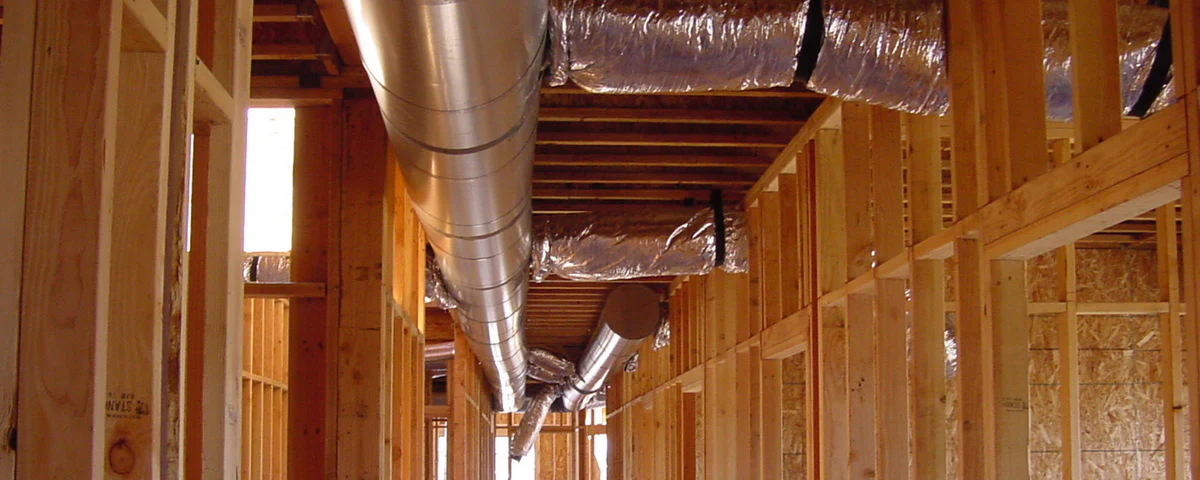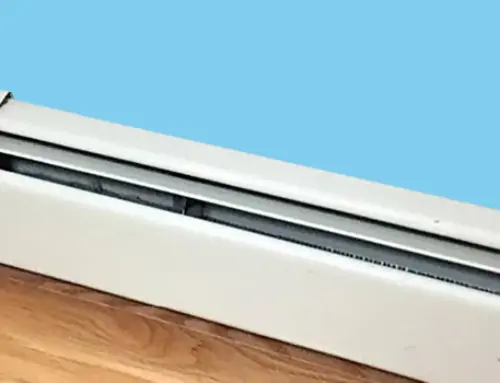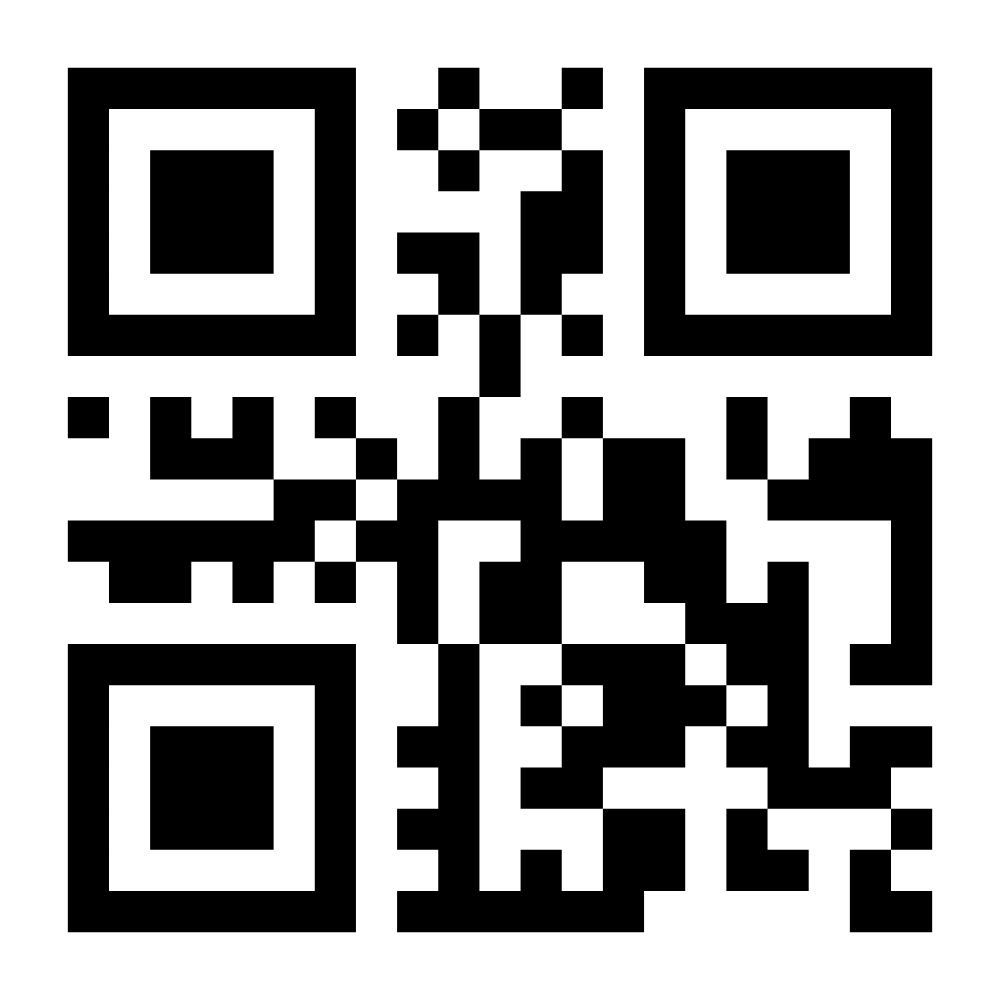What Is Forced Air Heating? Pros, Cons & Energy Tips for Midwest Homes
by Tyler Castle
21.3 min read
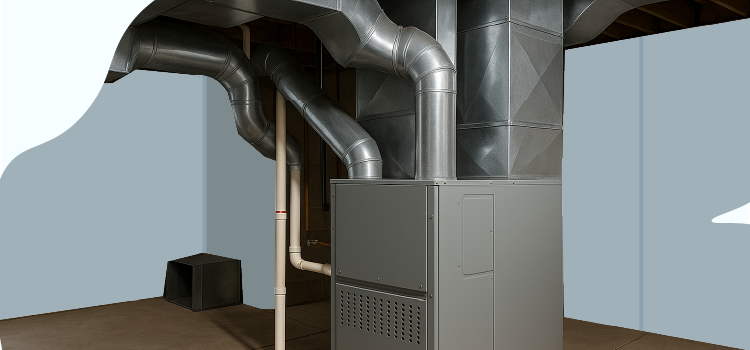
Forced air heating systems are among the most common ways to heat homes in states like Pennsylvania, Illinois, Ohio, and Michigan. But many homeowners aren’t sure how these systems actually work, how efficient they are, or whether they’re paying more than they should to stay warm through long, frigid winters.
As an energy supplier with over 35 years of experience in the heating industry, we’ve got answers and expert-backed insights for you. In this guide, we’ll break it all down, starting with what forced air heating means, how it compares to other systems like heat pumps and radiant heating, and why it behaves differently depending on your climate.
Plus, we’ll share smart energy tips specifically for Midwest homes, so you can stay warm and save money without overworking your system. Let’s dive in.
Key Points of This Article:
- Forced-air heating systems use a furnace to heat air, which is then distributed throughout the home via ducts and vents. The system creates a continuous cycle by pulling cooler air back to the furnace to be reheated.
- These systems heat homes quickly and work well with central air conditioning, but they can be noisy, dry out indoor air, and lose heat through leaky ducts. Regular maintenance is essential to keep them efficient.
- Gas-powered forced-air systems are ideal for cold Midwest winters due to their fast and reliable heating. However, electric versions can be costly to operate, and homes without existing ductwork may face expensive installation.
What Is Forced-Air Heating?
Forced-air heating is a type of home heating system that uses air as the medium to distribute heat throughout a building using a furnace and blower fan.
A forced-air heating system works by heating air inside a furnace, then pushing that warm air through a system of ducts and out through vents in each room to heat your home.
To keep the system flowing, as the air circulates, cooler air is pulled back through return vents in your forced-air heating system which is then reheated, creating a continuous cycle of warm airflow.
Forced-air systems are the most common type of heating system used in American homes, especially in colder regions like the Midwest. Most are powered by natural gas or electricity, and many are paired with central air conditioning to use the same ductwork for both heating and cooling.
Unlike a heat pump, which provides both heating and cooling, or a central air conditioning system, which only cools, a forced-air furnace is designed only to generate heat.
Although, the same ductwork can be used by both the furnace and the AC, which is why the two systems are often confused.
How Does Forced-Air Heating Work?
Do you have a forced air heating system and wonder how it actually works? We've done the research and have you covered. Here's a simple step-by-step breakdown of how it works:
- The thermostat detects a drop in temperature: When the indoor temperature falls below your set thermostat level, your forced air heating system kicks on to maintain the temperature you're looking for.
- The furnace heats the air: Once your system gets this alert, inside your forced air system often sits a furnace either powered by natural gas or electricity. This device is used to heat air to the desired temperature.
- The blower fan pushes the warm air through ducts: At the same time, a powerful fan then forces the heated air into the ductwork, which carries it to vents (or registers) throughout your home.
- Warm air comes out of the vents: As the vents carry warm air, it comes out your vents into specific rooms. From this, you'll feel the warm air blowing into each room, typically through wall, floor, or ceiling vents.
- Cooler air is pulled back to the furnace: Return vents suck cooler air from your home back to the furnace to be reheated, keeping the cycle going.
As energy experts, we know most systems also have a fan-only or "circulate" mode, which doesn't heat the air but moves it around your home.
This can help even out temperatures between rooms or improve air quality, especially if you're using air purifiers or humidifiers.
How Forced Heating and Air Differ from Other Heating Systems
It's easy to confuse forced-air with other systems, especially if you're not used to looking under the hood of your HVAC setup. Here's how forced air compares to three common alternatives:
Forced Air Systems vs. Alternatives
| System Type | How It Heats | Distribution Method | Key Differences |
| Forced Air | Heats air in a furnace | Ducts + blower fan | Fast, whole-house airflow |
| Radiant Heating | Heats surfaces (like floors or walls) | Radiates heat directly into rooms | Silent, slow warmth; no ducts |
| Boiler/Radiator | Heats water into steam or hot water | Pipes + radiators/baseboards | Consistent but slower heat |
| Baseboard Heaters | Uses electric resistance | Radiates from wall-mounted units | Individual room control, no fan |
Forced air heating systems create their heat using a furnace, ducts and blower fans and are excellent for whole-home heating. Radiant heating differs from forced air heating because it’s ideal for spot heating and heating specific surfaces with no ductwork needed.
On the other hand, a boiler is specifically used for heating water and isn’t ideal for heating like a forced air heater is. Boilers mainly use pipes and baseboard to distribute their heat and similar to radiant heating, they don’t use ductwork.
Lastly, baseboard heating is ideal for individual room heating and isn’t made for whole-home heating like a forced heat and air system. Baseboard heaters are typically wall-mounted and don’t need ductwork.
Parts of a Forced-Air Heating System
To truly understand how your heating system works, and how to get the most out of it, it helps to know the key parts that make up a system. Each component plays an important role in keeping your home warm during cold Midwest winters. If any of these parts fail or aren’t maintained, it can impact your comfort, increase your energy bills, or even shorten the lifespan of your system. Here’s what you need to know:
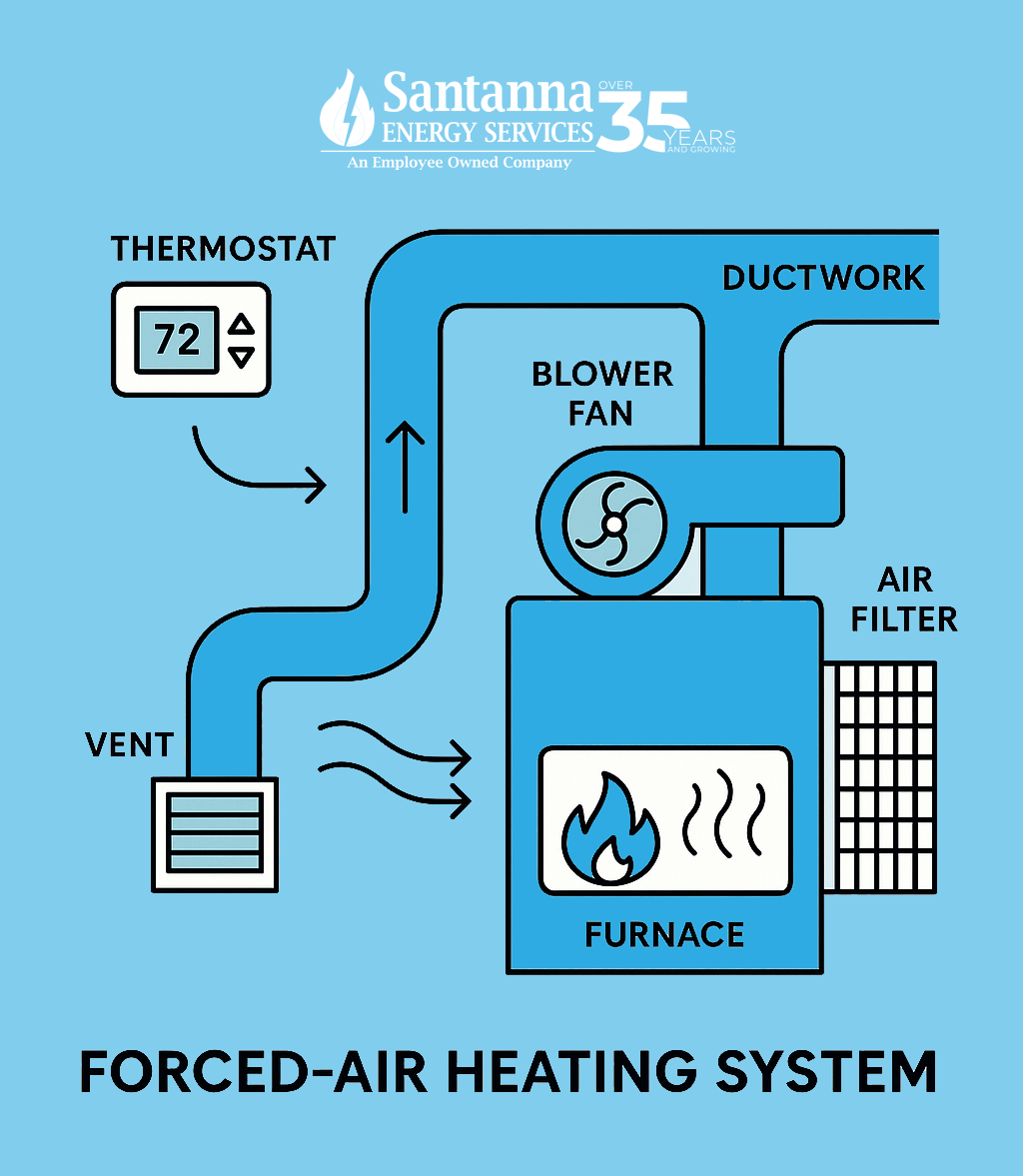
- Most Forced Air Heating Systems Come with a Furnace: This is the heart of your heating system. The furnace generates heat by either burning natural gas, using electric resistance coils, or using oil in older setups. Most Midwest homes use natural gas furnaces due to affordability and availability.
The U.S. Department of Energy reports that modern furnaces can reach efficiency levels of up to 98.5% AFUE (Annual Fuel Utilization Efficiency), meaning nearly all the fuel is converted to heat.
- The Second Most Important Part: The Blower Fan (Air Handler): Once the air is heated inside the furnace, the blower fan pushes it through your home’s ductwork. This fan is essential for moving warm air into each room. If your blower is weak or dirty, airflow becomes uneven, making it harder to heat your home efficiently.
- Your Warm Air Has to be Moved Somehow! Enter, the Ductwork (Supply and Return Ducts): Your duct system is like a network of highways for warm air. Supply ducts carry heated air from the furnace into different parts of your home and return ducts pull cooler air back to the furnace to be reheated.
If your ducts are leaky, poorly sealed, or uninsulated—common issues in older homes—you could lose about 20% to 30% of your heated air, according to ENERGY STAR.
- Forced Air Heating Systems Use a Thermostat: This is the control center of your system. You set the desired temperature, and the thermostat signals the furnace to turn on or off as needed.
As a bonus energy saving tip, we’ve found smart thermostats can help reduce energy use by learning your habits and automatically adjusting heating schedules.
- Don’t Forget Your Air Filter: Often overlooked, your air filter cleans the air before it enters the blower fan. It helps remove dust, pollen, and other particles. A clogged filter can restrict airflow, force your system to work harder, and increase your energy bill.
We recommend changing your filter every 3 months, especially during heavy use in winter because constant use causes it to clog faster, reducing airflow, raising energy bills, and putting strain on your system.
- Vents (Registers and Grilles): These are the visible openings in your walls, floors, or ceilings that release heated air into each room (supply vents) and pull air back in (return vents). Keep them clear of furniture and dust buildup for better performance.
Is My Forced-Air Heating System Gas or Electric?
Forced-air heating systems can run on either natural gas or electricity, depending on the type of furnace or heat source you have.
In the Midwest, gas-powered furnaces are the most common because natural gas tends to be cheaper and widely available. However, some homes use electric furnaces, especially in areas where gas lines aren’t accessible.
Others may rely on heat pumps, which also use forced air to distribute heat, but operate differently by transferring warmth rather than generating it directly.
Not sure which type you have? Here are some quick signs to tell:
- If you have a gas furnace, you’ll typically see a burner flame and hear a “whoosh” sound when it ignites. Your utility bill will show gas usage in therms.
- Electric furnaces may be quieter than gas and don’t require a flue or vent pipe. If you’re equip with an electric furnace, your bill will show higher electricity usage (kWh), especially in winter.
- If your system provides both heating and cooling and there’s no gas line connected, you likely have a heat pump.
What Does Forced-Air Heating Mean for My Home?
If you’re moving into a new home or renting for the first time, there’s a good chance you’ll come across a forced-air heating system, and you might not even realize it at first.
In simple terms, forced-air heating means your home uses a furnace to heat air and then blow that warm air through ducts to each room.
You’ll know you have forced air if you see rectangular metal vents or grilles on your floors, walls, or ceilings. These vents are how the warm air enters and exits each room, and they’re part of a larger duct system usually hidden behind your walls.
If a visual inspection doesn’t do the trick, no worries! Here’s what a forced air system feels like: The heat kicks in quickly, you may feel warm air blowing within a few minutes of adjusting the thermostat.
You may hear a whooshing or humming sound as the blower fan pushes air through the vents. The air may feel drier in winter, especially if you run the heat for long stretches of time.
Forced-air heating is extremely common in states like Illinois, Ohio, Pennsylvania, and Michigan because it works fast, can heat an entire home evenly, and is often paired with central air conditioning to use the same ductwork year-round.
That makes it a cost-effective solution for homeowners looking for both heating and cooling in one system.
Forced Air vs. Central Air: What’s the Difference?
A forced-air system is any HVAC setup that uses air to distribute heat throughout your home. The heat is usually generated by a gas furnace, electric furnace, or heat pump. Once the air is heated, a blower fan pushes it through the ducts to the rooms in your home. You’ll feel warm air coming out of your vents during winter.
A central air conditioning system, on the other hand, is used for cooling your home in the summer. It uses the same ductwork as your forced-air heating system, but instead of warming the air, it removes heat and humidity from inside your home and releases cool air through the vents.
People often refer to both systems as “central air” because they both use a central unit (like a furnace or AC condenser) and deliver air through ducts. But the key distinction is:
- Forced air = heating
- Central air = cooling
- Ductwork = shared between both systems
Knowing this helps you understand what type of maintenance is required and which part of your system you’re using, especially if your HVAC system isn’t functioning the way you expect.
If your thermostat is set to “Auto,” it can automatically switch between heating and cooling based on your set temperature range. For example, running your furnace in the cooler morning and your air conditioner in a warmer afternoon. But not all thermostats include this feature; many require you to manually switch between heat and cool modes.
Heat Pump Vs. Forced Air
Many homeowners confuse the heat pump and forced-air heating as well, but they’re very different.
The main difference between a forced air heating system and heat pump is the way each system handles air.
A forced air heating system uses a furnace to generate heat, and a heat pump doesn’t create heat, it transfers it. Heat pumps transfer outside air into your home using electricity, even in cold weather.
While both systems use ducts to distribute warm air, a heat pump can also cool your home in the summer, making it a year-round solution.
Pros & Cons of Forced-Air Heating
Like any heating system, it has advantages and drawbacks that can impact your comfort, energy usage, and long-term costs. Whether you’re buying a home, upgrading your heating system, or trying to lower your energy bills, here’s what you need to know about forced air heating:
Pros of Forced-Air Heating
- Heats the entire home quickly: Forced air warms up a home faster than systems like radiant or baseboard heat because warm air is pushed directly into every room.
- Works well with central air conditioning: Both systems use the same ductwork, which saves on installation and makes it easy to cool your home in summer.
- Compatible with programmable or smart thermostats: This makes it easier to manage your comfort and reduce energy usage with automated schedules.
- Easier and cheaper to install in new construction: Ducted systems are a common default for builders and HVAC contractors, especially in suburban homes, because they can heat and cool an entire house using one centralized system. According to HomeGuide, the average cost to install an HVAC zoning system typically range from $1,700 to $4,500. The final cost depends on factors like the number of zones, whether you’re retrofitting an existing duct system, and the size of your home.
- Air filtration is built-in: Forced-air systems include a filter, which can help improve indoor air quality by trapping dust, allergens, and pet dander.
- Widely available repair parts and service: Since forced air is so common, it’s easy to find technicians and affordable parts for maintenance and repairs.
- Can be upgraded with whole-home humidifiers or UV filters: Add-ons can help solve common comfort issues like dry air or airborne germs.
- Cost-effective when paired with natural gas: Gas furnaces tend to be cheaper to run in the Midwest compared to electric resistance heat or oil-based systems.
- Reliable performance in very cold climates: Unlike some heat pumps, gas-powered forced-air furnaces continue working well even in below-freezing conditions.
Cons of Forced-Air Heating
- Can be noisy: The blower fan, duct vibration, or air whooshing through vents can be disruptive—especially in older or poorly insulated homes.
- Heat loss through ducts: According to ENERGY STAR, 20% – 30% of heated air can be lost in leaky or uninsulated ducts—wasting energy and raising bills.
- Can dry out indoor air: Because forced air constantly moves heated air, it can reduce humidity levels and lead to dry skin, static electricity, and irritated sinuses.
- Uneven heating in multi-story or large homes: Heat often rises, leaving upper floors warmer and lower floors colder—unless your ducts are balanced or zoned properly.
- Requires regular maintenance: Filters must be changed regularly, and ducts may need cleaning or sealing to maintain efficiency and air quality.
- Potential to blow around dust, pollen, and allergens: If the filter isn’t changed or ducts aren’t clean, the system can circulate allergens rather than remove them.
- Installing Ducts in an Older Home Can Be Costly: Installing ducts in an existing home (without any) can be expensive and invasive.
- Takes up space in the attic, basement, or crawlspace: The furnace and ductwork require significant room, which can limit storage or renovation flexibility.
- System-wide impact if one part fails: A blower fan, duct leak, or thermostat issue can affect comfort throughout the whole house—not just in one room.
What’s the Most Efficient Forced Air Setup?
The most efficient forced-air heating system isn’t just about the furnace, it’s a combination of parts working together to deliver steady, reliable heat without wasting energy. Here’s what the ideal high-efficiency setup looks like:
-
A High-Efficiency Furnace
The heart of any forced-air system is the furnace. The most efficient models are ENERGY STAR® certified and have an AFUE rating of 90% or higher—which means at least 90% of the fuel you pay for turns into usable heat.
Newer units can reach up to 98.5% efficiency, while older models, especially 15-20 years old may waste a lot of energy in the heating process. A highly efficient furnace is the key to the most efficient system.
-
A Variable-Speed or Two-Stage Blower Fan
Instead of running at full power all the time, an efficient blower adjusts airflow based on how much heat your home needs. This uses less electricity, keeps the temperature more stable, and reduces how often your system turns on and off.
-
Sealed and Insulated Ductwork
Even with the best furnace, you’ll lose heat if your ductwork is leaky or poorly insulated. According to ENERGY STAR, 20% to 30% of heated air is lost through gaps in ducts, especially in attics, crawlspaces, and basements.
A high-efficiency setup includes tight, sealed ductwork that delivers warm air where it’s needed, without waste.
-
A Smart Thermostat
An efficient system needs smart control. Smart thermostats allow you to schedule temperature changes, adjust settings remotely, and even learn your heating habits to save energy. This can reduce your annual heating costs by up to 10%, according to the U.S. Department of Energy.
Is a Forced Air Heating System Right for Midwest Homes?
If you live in the Midwest—like Ohio, Illinois, Michigan, or Pennsylvania—you’ll need a heating system that can handle long, cold winters. Forced-air heating is one of the most popular options for this region because it warms up your home quickly and works well when temperatures drop below freezing.
But is it the right fit for your home? Let’s look at a few things that matter.
Forced-air systems (especially gas ones) are great in places with cold snaps because they push warm air into every room fast. If you live in a place where it regularly dips below 20°F, forced air can keep up with that cold better than some other systems.
What About Energy Costs?
If you’re trying to choose the most cost-effective heating system for your home, it’s important to compare the total cost of running different system types, not just whether it’s powered by gas or electricity.
Below is a breakdown of how forced-air heating systems compare to radiant floor heating and electric heat pumps, assuming 8 hours of heating per day over a full Midwest winter.
Estimated Winter Heating Costs (Midwest, 8 hours/day, 4 months at $.54/therm & 17.45 cents per KWH)
| Heating System | Energy Type | Monthly Cost | Winter Cost (4 mo.) | Notes |
| Forced Air (Gas Furnace) | Natural Gas | $130 | $520 | Common in Midwest homes, fast whole-home heat |
| Forced Air (Electric Furnace) | Electricity | $450–$475 | $1,800–$1,900 | Easy to install, but costly to operate in cold climates |
| Radiant Floor Heating | Electricity | $400–$450 | $1,600–$1,800 | Comfortable and even heat, but slower to warm up |
| Air-Source Heat Pump | Electricity | $250–$350 | $1,000–$1,400 | Most efficient in mild temps; may need backup heat in Midwest |
Note: Actual costs vary based on system efficiency, home size, insulation, and utility rates. These estimates are based on average Midwest rates as of 2025.
Bottom Line
Gas forced-air heating is still the most cost-effective option for cold Midwest winters if your home already has ductwork.
Heat pumps offer the best energy efficiency but may struggle in sub-freezing temps—making them ideal for hybrid systems and radiant heating is comfortable but slower and more expensive to run on electricity. Lastly, electric furnaces are easy to install but can be up to 4x more expensive to operate in colder climates.
What Kind of Homes Work Best with Forced Air Heating?
After some research, we've found that forced air works well in medium to large homes, homes that already have ducts and vents and multi-story homes, as long as the airflow is balanced.
Forced air may not be the best fit for small homes or apartments, older homes with no ductwork (since adding ducts can be expensive) and homes with allergy concerns (unless you change filters often).
Will Forced-Air Heating Raise or Lower My Energy Bills?
It depends. The cost of running a forced-air heating system varies based on your energy source, your system's efficiency, and how well your home retains heat.
Here's what matters most:
- Natural gas is usually the more affordable option in Midwest states like Ohio, Illinois, and Pennsylvania.
- Electric furnaces tend to cost more to run, especially in the dead of winter.
Older or oversized furnaces waste more energy—especially if they're over 15 years old. Systems with leaky or uninsulated ducts can lose 20–30% of heated air, according to ENERGY STAR. Smart upgrades like programmable thermostats or dual-stage blowers can lower costs.
A home with poor insulation or high thermostat settings will see much higher heating bills. Heating for 8 hours a day during a 4-month Midwest winter adds up, especially with an electric furnace.
Forced-Air Heating System Maintenance
Here are the most important maintenance tasks every homeowner should know about:
- Change Your Furnace Filter Regularly: A dirty filter blocks airflow, making your system work harder and costing you more money. Be sure to change your filter every 1–3 months to avoid a loss of energy.
- Inspect Your Vents and Return Grilles: Blocked vents can cause uneven heating and increase pressure on your blower fan. Be sure to assess your vents on a monthly basis for obstructions and keep furniture and curtains away from vents for better airflow.
- Seal and Insulate Ductwork: ENERGY STAR estimates that 20–30% of heated air is lost through leaky ducts, especially in attics and basements. Inspect every couple of years or if you notice weak airflow.
- Schedule a Professional Furnace Tune-Up: An HVAC technician can check for safety issues (like carbon monoxide leaks), test efficiency, and clean components. Do this once a year, ideally in the fall before peak usage.
- Test Your Thermostat: A faulty thermostat can cause your system to short-cycle or run constantly. Consider upgrading to a programmable or smart thermostat for energy savings and consistancy.
- Listen for Unusual Noises: Banging, screeching, or rattling could be a sign of a loose part, worn-out blower motor, or blocked airflow. Immediately addressing these issues early can prevent costly repairs.
FAQs
What does it mean when heating is forced air?
Forced-air heating means your home uses a system (usually a furnace) that heats air and uses a blower fan to distribute that warm air through ducts and vents into your rooms.
Is forced air the same as central heating?
Not exactly. Forced air is a type of central heating. Central heating refers to any system that heats the whole home from one point—forced air is just the most common version, using heated air and ducts.
Do I need a different energy plan if I have forced air?
You might. If your furnace is electric, your electricity usage will spike in winter, so a flat-fee or Unlimited electric plan can help you avoid supply charge hikes.* If it's gas-powered, compare gas suppliers if you live in a deregulated market.
Why does my forced air system feel uneven?
Common causes include leaky or unbalanced ducts, clogged filters, or a poorly sized system. Hot air may rise to upper floors while lower levels stay cooler. Zoning systems or duct sealing can help.
Should I replace my forced air system with a heat pump?
It depends on your climate and home setup. Heat pumps are efficient in milder winters, but in colder Midwest states, they may need backup heat. Hybrid systems (heat pump + furnace) offer the best of both.
Can I convert baseboard heat to forced air?
Yes, but it can be expensive. Converting to forced air requires installing ducts and vents, which may involve cutting into walls and ceilings. It's easiest during major renovations or new construction.
Forced-air heating has long been a trusted choice for Midwest homeowners and for good reason. It heats quickly, covers your whole home, and holds up during harsh winters.
But reliability doesn't always mean efficiency. The real cost of staying warm depends on more than just your system; it's influenced by your fuel type, how well your home holds heat, and what kind of energy plan you're on.
If you're using forced air, now's the perfect time to take a closer look, not just at your furnace, but at the plan powering it.
Looking for a way to make your electricity costs a little more predictable? Consider Santanna's Unlimited Energy Plan! Enjoy stable supply charges each month no matter how much you use.*
* Restrictions apply. Enrollment based upon program eligibility. Customers using more than 125% of normal monthly usage as determined by Santanna may be required to switch plans.
Tyler is an experienced energy professional, having worked for Santanna Energy Services, for the past four years. He is passionate about renewable energy and believes that diversifying the energy grid is the key to a sustainable future. Tyler is dedicated to supplying consumers with the best possible energy solutions and works diligently to make sure that Santanna can deliver the highest quality service.


